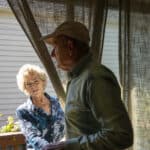The week before my mother-in-law turned 98, I received a call at 3:15 in the afternoon saying that her assisted living facility would stop family visitation as of 6 p.m. that evening because of COVID-19. She lives in a CCRC (Continuous Care Retirement Community) which accommodates independent, assisted and skilled nursing.
As I was near the exit to her community, I drove straight there. I called my husband, her son, and requested that he go to our house, gather whatever she might need and head over. We decided to also bring cleaning supplies as we didn’t know if that service would be interrupted as well.
That was March 12, 2020. Three weeks later the staff organized Zoom calls, weekly, for 15 minutes. Ten weeks later, they added a 10-minute “drive by” where we would remain in our car with a mask and they would bring my mother-in-law within six feet of the car to visit.
Those drive-by visits evolved into 30-minute outdoor visits, socially distanced and masked. They were curtailed when a staff member tested positive; the short visits resumed two weeks later.
As of late February of this year, all the staff and residents had received both doses of the COVID-19 vaccine, but the community, which is following CDC guidelines, had not expanded visitation beyond the weekly 30-minutes visits, held outdoors and socially distanced.
There have been many communication challenges ever since COVID hit:
• While the drive-by visits were a wonderful idea, our loved one has macular degeneration and the time of day, with the angle of the sun, made that first visit difficult for her. Even with sunglasses and an umbrella perched near her, she really could not see us.
• She has reached the stage of life where technology is not her friend. She never got the “hang” of a smart phone. Therefore, something like Facetime has not been an option for us.
• The isolation has caused some confusion with elapsed time. This evidently has happened with some others there as well. The calendar is clear to her on what day it is. But the connection of what happened yesterday or that mailing something yesterday doesn’t mean we’ve got it today.
• When there has been an occasional power outage, her answering machine needed to be reset. Or during a recent storm, her regular phone went out for several hours. We asked staff to find her cell phone and give it to her. These are things we took for granted that we could “run over there” and fix.
Since we know how important connection is to thriving — from the beginning we considered what we could have done to keep her engaged for more than one 15-minute interaction per week. We looked at video-calling devices. For a younger person, getting an iPhone or iPad would be the logical option. But we couldn’t get in there to give her a tutorial. We looked at the Facebook Portal because it is always “on” and it doesn’t require the multiple steps that other devices may.
We did end up utilizing the Facebook Portal. She wasn’t wild about it at first but has come around. It is still a challenge because we do have to call her first, make sure she’s at her desk, and then guide her through where to touch the screen to accept the video chat. That sometimes can take several tries. We did a family chat on Christmas day and we took turns opening gifts. As the phone company ad from the 1960s said: “It’s the next best thing to being there.”
Interestingly, my mother-in-law’s cognitive functioning is improving. At her age, she may have still been recovering from illness at the beginning of the year and then the isolation delayed improvement. Her rate of speech isn’t slow and her sense of humor is sharp. Along with that has come the realization of isolation. So she actually is feeling it more now than in the beginning.
I suppose the decision by health care facilities to keep family away from loved ones may have been the only realistic option to control the spread of COVID-19. Still, banning families from nursing homes and hospitals has contributed to a shocking rapid decline of many of those residents and patients.
To get a national view of the scope of how COVID-19 may impact retirement and living arrangements, I recommend you read the Wall Street Journal article “How Covid-19 Will Change Aging and Retirement,” written by Anne Tergesen. She addresses multiple issues for consideration.
I do think there will be many continuing challenges brought on by COVID-19, especially for our older clients who face choices about changing their living arrangements. Aging at home could become more popular and viable if technology to enable that is affordable.
I hope there will be a move away from traditional nursing homes and toward smaller living arrangements where less than a dozen people live in a residential neighborhood home.
Some medical professionals have projected that the pandemic may shorten life expectancy by a few years, but many of our clients will still be living much longer lives than those in previous generations.
Advisors may want to read the book “The 100-Year Life” by Lynda Gratton and Andrew Scott. We, as advisors, face resistance from our clients who have a difficult time imagining living so long. We have a responsibility to them to guide them through planning for that possibility.
Our analysis may impact their plans to relocate, either because they realize they can’t afford to do so or it may lead to other decisions, such as moving to a location that is more progressive with a senior living development. Either way, we can help make clients make more thoughtful decisions on where they want to live.
At the same time, changes at the state or federal level may also impact what living choices become viable for older people. For example, Medicare’s increased use of telemedicine may be a starting point to create other efficient delivery of health care that make it easier for people to age in place longer.
I also believe that advisors can have an impact on these issues. For starters, advisors throughout the country should make a greater effort to share ideas about what new kinds of living arrangements are being implemented in their areas. Those ideas might help advisors in other locales better serve their clients.
Joan B. Cox, CFP®, CeFT®, is a financial planner with Transitus Wealth Partners. She is located in Covington, La., and helps clients navigate major life events and the financial transitions that accompany them.







